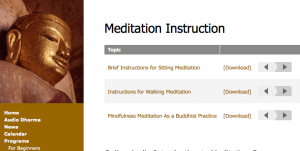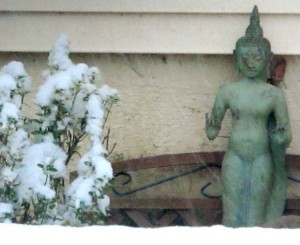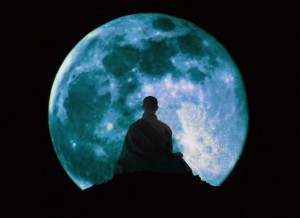At its Tuesday, Jan. 12 meeting, the meditation group continues its discussion of excerpts from Bhante Gunaratana’s classic guide to meditation practice, “Mindfulness in Plain English.” As we consider the basics of insight or vipassana meditation in the Buddhist tradition, Bhante G discusses what meditation in this tradition does NOT encompass.

What Meditation Isn’t
Excerpt from “Mindfulness in Plain English,” Chapter 2
Meditation is a word. You have heard this word before, or you would never have picked up this book. The thinking process operates by association, and all sorts of ideas are associated with the word ‘meditation’. Some of them are probably accurate and others are hogwash. Some of them pertain more properly to other systems of meditation and have nothing to do with Vipassana practice. Before we proceed, it behooves us to blast some of the residue out of our own neuronal circuits so that new information can pass unimpeded. Let us start with some of the most obvious stuff.
Unless your life is immoral and chaotic, you can probably get started right away and make some sort of progress. Sounds fairly encouraging, wouldn’t you say?
We are not going to teach you to contemplate your navel or to chant secret syllables. You are not conquering demons or harnessing invisible energies. There are no colored belts given for your performance and you don’t have to shave your head or wear a turban. You don’t even have to give away all your belongings and move to a monastery. In fact, unless your life is immoral and chaotic, you can probably get started right away and make some sort of progress. Sounds fairly encouraging, wouldn’t you say?
There are many, many books on the subject of meditation. Most of them are written from the point of view which lies squarely within one particular religious or philosophical tradition, and many of the authors have not bothered to point this out. They make statements about meditation which sound like general laws, but are actually highly specific procedures exclusive to that particular system of practice. The result is something of a muddle. Worse yet is the panoply of complex theories and interpretations available, all of them at odds with one another. The result is a real mess and an enormous jumble of conflicting opinions accompanied by a mass of extraneous data.
This book is specific. We are dealing exclusively with the Vipassana system of meditation. We are going to teach you to watch the functioning of your own mind in a calm and detached manner so you can gain insight into your own behavior. The goal is awareness, an awareness so intense, concentrated and finely tuned that you will be able to pierce the inner workings of reality itself.
There are a number of common misconceptions about meditation. We see them crop up again and again from new students, the same questions over and over. It is best to deal with these things at once, because they are the sort of preconceptions which can block your progress right from the outset. We are going to take these misconceptions one at a time and explode them.
MISCONCEPTION No. 1:
Meditation is just a relaxation technique
The bugaboo here is the word ‘just’. Relaxation is a key component of meditation, but Vipassana-style meditation aims at a much loftier goal. Nevertheless, the statement is essentially true for many other systems of meditation. All meditation procedures stress concentration of the mind, bringing the mind to rest on one item or one area of thought. Do it strongly and thoroughly enough, and you achieve a deep and blissful relaxation which is called Jhana. It is a state of such supreme tranquility that it amounts to rapture. It is a form of pleasure which lies above and beyond anything that can be experienced in the normal state of consciousness. Most systems stop right there. That is the goal, and when you attain that, you simply repeat the experience for the rest of your life.
Not so with Vipassana meditation. Vipassana seeks another goal–awareness. Concentration and relaxation are considered necessary concomitants to awareness. They are required precursors, handy tools, and beneficial byproducts. But they are not the goal. The goal is insight. Vipassana meditation is a profound religious practice aimed at nothing less that the purification and transformation of your everyday life. We will deal more thoroughly with the differences between concentration and insight in Chapter 14.
Misconception No. 2:
Meditation means going into a trance
Here again the statement could be applied accurately to certain systems of meditation, but not to Vipassana. Insight meditation is not a form of hypnosis. You are not trying to black out your mind so as to become unconscious. You are not trying to turn yourself into an emotionless vegetable. If anything, the reverse is true. You will become more and more attuned to your own emotional changes. You will learn to know yourself with ever- greater clarity and precision.
In learning this technique, certain states do occur which may appear trance-like to the observer. But they are really quite the opposite. In hypnotic trance, the subject is susceptible to control by another party, whereas in deep concentration the meditator remains very much under his own control. The similarity is superficial, and in any case the occurrence of these phenomena is not the point of Vipassana. As we have said, the deep concentration of Jhana is a tool or stepping stone on the route of heightened awareness. Vipassana by definition is the cultivation of mindfulness or awareness. If you find that you are becoming unconscious in meditation, then you aren’t meditating, according to the definition of the word as used in the Vipassana system. It is that simple.
Misconception No. 3:
Meditation is a mysterious practice which cannot be understood
Here again, this is almost true, but not quite. Meditation deals with levels of consciousness which lie deeper than symbolic thought. Therefore, some of the data about meditation just won’t fit into words. That does not mean, however, that it cannot be understood. There are deeper ways to understand things than words. You understand how to walk. You probably can’t describe the exact order in which your nerve fibers and your muscles contract during that process. But you can do it. Meditation needs to be understood that same way, by doing it. It is not something that you can learn in abstract terms. It is to be experienced. Meditation is not some mindless formula which gives automatic and predictable results. You can never really predict exactly what will come up in any particular session. It is an investigation and experiment and an adventure every time. In fact, this is so true that when you do reach a feeling of predictability and sameness in your practice, you use that as an indicator. It means that you have gotten off the track somewhere and you are headed for stagnation. Learning to look at each second as if it were the first and only second in the universe is most essential in Vipassana meditation.
Misconception No. 4
The purpose of meditation is to become a psychic superman
No, the purpose of meditation is to develop awareness. Learning to read minds is not the point. Levitation is not the goal. The goal is liberation. There is a link between psychic phenomena and meditation, but the relationship is somewhat complex. During early stages of the meditator’s career, such phenomena may or may not arise. Some people may experience some intuitive understanding or memories from past lives; others do not. In any case, these are not regarded as well-developed and reliable psychic abilities. Nor should they be given undue importance. Such phenomena are in fact fairly dangerous to new meditators in that they are too seductive. They can be an ego trap which can lure you right off the track. Your best advice is not to place any emphasis on these phenomena. If they come up, that’s fine. If they don’t, that’s fine, too. It’s unlikely that they will. There is a point in the meditator’s career where he may practice special exercises to develop psychic powers. But this occurs way down the line. After he has gained a very deep stage of Jhana, the meditator will be far enough advanced to work with such powers without the danger of their running out of control or taking over his life. He will then develop them strictly for the purpose of service to others. This state of affairs only occurs after decades of practice. Don’t worry about it. Just concentrate on developing more and more awareness. If voices and visions pop up, just notice them and let them go. Don’t get involved.
Misconception No. 5
Meditation is dangerous and a prudent person should avoid it
Everything is dangerous. Walk across the street and you may get hit by a bus. Take a shower and you could break your neck. Meditate and you will probably dredge up various nasty matters from your past. The suppressed material that has been buried there for quite some time can be scary. It is also highly profitable. No activity is entirely without risk, but that does not mean that we should wrap ourselves in some protective cocoon. That is not living. That is premature death. The way to deal with danger is to know approximately how much of it there is, where it is likely to be found and how to deal with it when it arises. That is the purpose of this manual.
Vipassana is development of awareness. That in itself is not dangerous, but just the opposite. Increased awareness is the safeguard against danger. Properly done, meditation is a very gently and gradual process. Take it slow and easy, and development of your practice will occur very naturally. Nothing should be forced. Later, when you are under the close scrutiny and protective wisdom of a competent teacher, you can accelerate your rate of growth by taking a period of intensive meditation. In the beginning, though, easy does it. Work gently and everything will be fine.

Read ahead for Bhante G’s six additional thoughts on misconceptions about insight meditation. The group will consider the second part of the chapter at its Jan. 19 meeting. | READ ON





 Here is an online meditation resource
Here is an online meditation resource













